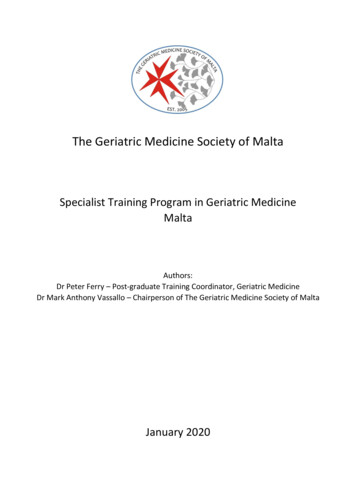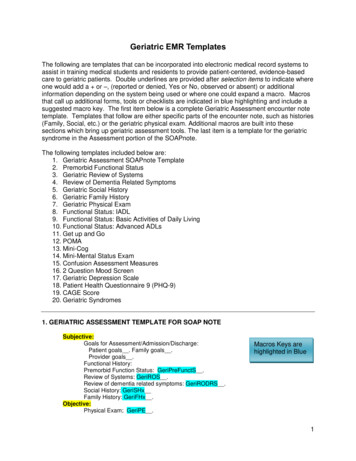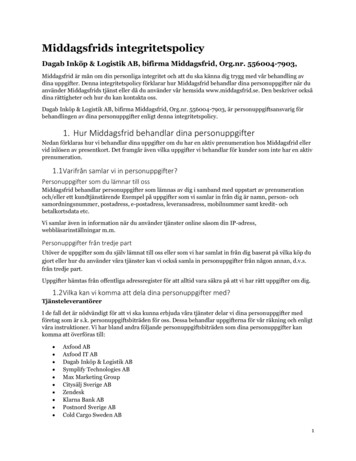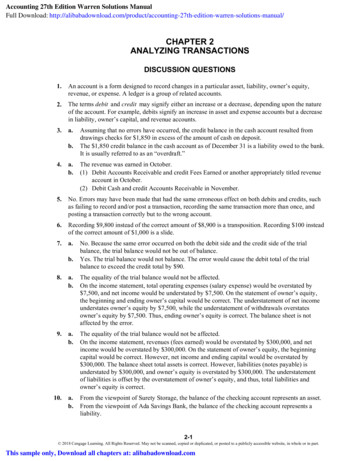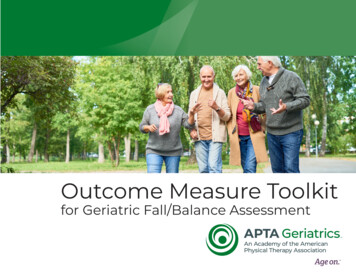
Transcription
Outcome Measure Toolkitfor Geriatric Fall/Balance Assessment
Table of ----------------------------------------- 2Background of the Outcome Measure Toolkit ProjectTaskforce --------------------------------------- ---------------------- 5Outcome Measure Toolkit Project Searching Key Words and ----------------- 6Outcome Measure Toolkit Project Search/Review Flow Chart ------------------------ 8Master List of Outcome Measures Assessing Balance/Fall Risk Being - 9Outcome Measures with Evidence of Psychometric Properties and Fall Risk Predictability---------------------------------- 12Outcome Measures Not Supported in Relation to Balance/Fall Assessment in the Older Adult Population and Rationales ----- 13Outcome Measures Related to Balance/Fall Risk Assessment but Warranting Additional Research for Further Validation ---- 15Outcome Measures Widely Used, but With Limited Recent Evidence Related to Fall RisksOutcome Measures Divided by -- 20Summary Tables of Each Individual Outcome Measure (in alphabetic order)Discussion---------------------------------- -- ---------------------------- 121Appendixa. Compiled List of Outcome Measures Found During Phase 1 Searchb. Outcome Measure Toolkit Project Article Review Instructionsc. Outcome Measure Summary Table ------ --------- ------------------------ 1271
IntroductionNovember 2019Dear fellow therapists:Welcome to the Outcome Measure Toolkit. I am excited to present this document to you. The Outcome Measure Toolkit projectis a product of the Balance & Falls Special Interest Group (BFSIG) of APTA Geriatrics, an Academy of the American PhysicalTherapy Association (APTA).Falls are the most common cause of injuries and hospital admissions in older adults, and balance is a potentially modifiablefactor known to contribute to falls—choosing proper tests and measures is a critical component of balance and fall riskassessment. Evidence-based interventions can then be implemented to improve participation, activity limitations, andimpairments of body structure and function for people with balance deficits and risks of falling. In recent decades, an enormousamount of outcome measures have been developed to evaluate balance and to predict fall risk. As fall risks and balanceassessments are multidimensional and multifaceted, selecting the optimal outcome measure is challenging.The BFSIG decided to take on the challenge to create the Outcome Measures Toolkit, providing our members with an updatedsummary of current outcome measures related to balance and fall risk assessment. As the BFSIG Research Liaison, I amhumbled and honored to lead the project.The Outcome Measure Toolkit took over two years to ready itself; fourteen taskforce members volunteered their time, effort,and knowledge to make this project possible. We started using keywords to search related outcome measures. The originalcompiled list had over 245 outcome measures! After multiple conferences, discussions, and endless hours of hard working, wenow present you with the final list of 107 outcome measures. We hope you find this Toolkit helpful, clinically andacademically. For this Toolkit to remain current, the list needs to be updated every three to five years. We hope to see morevolunteers devote themselves to updating this project in the future. Your participation and contribution help the BFSIG growand expand!Sincerely,Elizabeth Wang-Hsu, PT, PhDElizabeth Wang-Hsu, PT, PhDChair, the Outcome Measure Toolkit ProjectResearch Liaison, Balance and Fall Special Interest GroupUniversity of Pennsylvania Health System2
Background of the Outcome Measure Toolkit Project Purposes:1. Create an updated summary in the form of an Outcome Measure Toolkit for balance and fallassessment, including the psychometric properties, fall predictability, population validated, andreferences of each outcome measure in a simple, easy to understand table format.2. Provide all APTA Geriatrics members a toolkit to easily access current and existing BF outcomemeasures, with their psychometric properties and fall predictability in the geriatric population at varioussettings or with different diagnosis. Process and Phases of the Project:The project was initiated immediately after CSM 2017. Originally, 8 members from BFSIGvolunteered to form the taskforce for this project. A few members withdrew from the project due tovarious personal reasons, but new members joined the project. The taskforce members in various stagesare acknowledged in the following page.The project was conducted in five phases: Phase 1 was finding combinations of key words used to thoroughly search for any existing outcomemeasures that are appropriate for balance and fall assessment. From this search, 260 outcomemeasures were identified. The results were then streamlined to make a consensus master list of 107outcome measures. Phase 2 was the literature review process. The master list of outcome measures was assigned totaskforce members to review. Each member in each timeline was assigned 3 to 5 outcome measures.Phone conferences were held between each timeline to discuss issues and concerns from taskforcemembers. Phase 3 was cross-validation and recommendations. Phase 4 was updating of literature from 2018-2019. Phase 5 was formatting of the BFSIG Outcome Measure Toolkit and dissemination.3
The Outcome Measure Toolkit is a toolkit based on consensus opinion of experts from the BFSIG. It is aresource/toolkit for members but should not be confused or mistaken for peer-reviewed evidence-baseddocument. The BFSIG Outcome Measure Toolkit seeks to offer a quick summary with generalizability, aswell as various practice settings, in addition to community-dwelling. Furthermore, the emphasis of thisproject was placed on current literature in the past 5 or so years. This allows us to make recommendationson outcome measures which may no longer be valid with the changing features of the human populationincluding the prevalence rate of medical comorbidities, life expectancy, and medical advances.4
Taskforce MembersThe APTA Geriatrics Balance & Fall Special Interest Group would like to recognize and extend itsgratitude to the taskforce members, who volunteered their time, effort, and knowledge to this project.Elizabeth Wang-Hsu, PT, PhD (Chair)Research Liaison for APTA Geriatrics Balance and Falls SIG 2016-2019Heidi Moyer*†, PT, DPT (Co-Chair for the initial phases)Secretary, APTA Geriatrics Balance and Falls SIGEastern Regional Coordinator, APTA Geriatrics State Advocate ProgramCarmen Casanova Abbott, PT, PhD (Co-Chair for the final phases)Core Taskforce MembersAnne Reilley*, PT, DPT, MSSusan Glenney*†, PT, DPTMariana Wingood*†, PT, DPTAdjunct Taskforce MembersRyan Allison, PT, DPTHarsha Dhingra†, PT, MSEmma Phillips, PT, DPTHaim Nesser†, PT, DPTPaula Graul*†, PT, MSShweta Subramani†, PT, MHSAshley Bell, PTAJennifer Vincenzo*, PT, MPH, PhD (Chair, BFSIG)* Board Certified Clinical Specialist in Geriatric Physical Therapy (GCS)† Certified Exercise Expert for Aging Adults (CEEAA)5
Outcome Measure Toolkit Project Searching Key Words and DatabaseCombination of Words:Falls, Fall Risk, Balance, Functional Mobility, Strength, Older Adults, Aged, Geriatric, Elderly, Frail, Community-Dwelling,Independent Living, Nursing Home, Institutionalized, Skilled Nursing Facility, Residential Care, Long Term Care, OutcomeMeasure, Assessment.Database Searched:PubMed, CINAHL, Google Scholar, PsychInfoFallsWordDefinitionFallsAny event that leads to an unplanned, unexpected contact with a supporting surface. This does NOT include falls that are theresult of an outside force such as a push or shove or falls that are the result of a medical event such as a MI, syncope or fainting.Population ExaminedWordDefinitionOlder AdultsAccording to Medicare, a person over the age of 65 years.ElderlyOlder adults or aged individuals.AgedA person 65 through 79 years of age. For a person older than 79 years, AGED, 80 and over is availableAged, 80 and overA person 80 years of age and older.Frail elderly (Elderly, Frail)Older adults or aged individuals who are lacking in general strength and are unusually susceptible to disease or to otherinfirmity.6
Frail Older AdultsA person 65 or older who are lacking in general strength and are unusually susceptible to disease or to other infirmity.Community-Dwelling AdultsAccording to SoG CPG Committee: a person over age of 65 residing in the community or assisted living without distinctionabout health/frailty status.Independent LivingA housing and community arrangement that maximizes independence and self-determination.Item ExaminedWordDefinitionOutcome AssessmentResearch aimed at assessing the quality and effectiveness of health care as measured by the attainment of a specified end resultor outcome. Measures include parameters such as improved health, lowered morbidity or mortality, and improvement ofabnormal states (such as elevated blood pressure).Outcome MeasureEvaluations of the efficacy/effectiveness of an intervention on the premise of gauges taken prior to, during, and following theintervention.7
Outcome Measure Toolkit Project Search/Review Flow ChartDecember 2016Presentation of the Purpose/Mission of Outcome Measure Project to BFSIGexecutives; Recruit Taskforce Members via BFSIG emailsFebruary 2017First Conference Call;Discuss Search Strategies, Keywords, Database, etc.March 2017Initial Delegation; Key Words Search Balance/Fall-Related Outcome MeasureApril 2017Compile List From All Members : 245 Outcome Measures Identified(By Heidi Moyer & Elizabeth Wang-Hsu)ExcludedNot Related to Balance, Falls, FunctionalMobility, or Stength (i.e., MiniCog, MMSE)May 2017Master List of Outcome Measures: 107 Outcome Measures(By Taskforce Consensus)June 2017Outcome measures critically reviewedOutcome measure tables developedFirst recommendations made(By Taskforce Members)December 2018Cross validation of outcome measuresOutcome measure recommendation finalizedMay 2019Update outcome measures literature reviewOctober 2019Format BFSIG Outcome Measure Toolkit (By Carmen Abbott & Elizabeth Wang-Hsu)BFSIF Executives Internal ReviewAGPT review of Outcome Measure ToolkitDissemination8
Master List of Outcome Measures Assessing Balance/Fall Risk Being 18.19.20.2 Minute Walk Test & other similar timedwalks such e.g., 6 Minute Walk21 Item Fall Risk Index25 Question Geriatric Locomotive FunctionScale30 Second Chair Stand Test360 Degree Turn Time4 Step Square Test4 Stage Test, or Frailty and Injuries:Cooperative Studies of InterventionTechniques (FICSIT-4)5 Times Sit to Stand &10 Times Sit to StandActivities Specific Balance Confidence Scale(ABC)Activities Specific Fall Caution ScaleActivity-Based Balance and GaitAlternate Step TestAttitudes to Falls-Related InterventionsScalesBalance Evaluation Systems Test (BESTest;BESTmini; BESTbrief)Balance Outcome Measure for ElderRehabilitation (BOOMER)Balance Self-Efficacy TestBalance Self-Perceptions TestBed Rise Difficulty (BRD) ScaleBerg Balance ScaleBrunel Balance 4.35.36.37.38.39.40.41.42.43.44.Canadian Occupational PerformanceMeasureClinical Test of Sensory Interaction andBalance (CTSIB)Community Balance and Mobility ScaleScale of Balance Confidence (CONFbal)Conley ScaleDemura's Fall Risk Assessment Chart(DFRA)Downton Fall Risk IndexDynamic Gait IndexElderly Fall Screening TestElderly Mobility ScaleEuroqualFall Handicap InventoryFall Perception QuestionnaireFall Prevention Strategy SurveyFall Risk for Older People in the CommunityAssessmentFalls Behavioral ScaleFalls Efficacy Scale (FES)Fear Avoidance Beliefs Questionnaire(FABQ)Figure 8 Walking TestFloor Rise TestFrenchay Activity IndexFugl-Meyer Motor AssessmentFullerton Advanced Balance Scale (FAB)Functional Ambulation Category9
nal Fitness TestFunctional Gait AssessmentFunctional Independence Measure (FIM)Functional Mobility Assessment Tools (FMA)Functional Reach TestGait Abnormality Rating ScaleGait Efficacy ScaleGait Speed (m/s)Geriatric Fear of Falling AssessmentGlobal Deterioration ScaleGoal Attainment ScaleGorningen Activity Restriction ScaleGrip StrengthGuralnik Test BatteryHauser Ambulation IndexHealth-Related Quality of LifeHendrich II Fall Risk ModelHigh Level Mobility Assessment ToolHome Falls and Accidental Screening ToolInternational Physical Activity QuestionnaireL Test of Functional MobilityLASA Fall Risk ProfileLate-Life Function and Disability InstrumentMissouri Alliance for Home Care(MAHC-10)Melbourne Fall Risk Assessment Tool(MFRAT)Minimal Chair Height Standing AbilityMobility Interaction Fall ChartMorse Fall ScaleMotor Fitness ScaleMultiple Lunge TestMultiple Sclerosis Walking 90.91.92.93.94.95.96.97.98.99.100.101.Norwegian General Motor FunctionAssessmentPenisual Health Fall Risk Assessment Tool(PHRAT)Perceived Participation and AutonomyPeter James Centre Fall Risk AssessmentToolPhysical Activity QuestionnairePhysical Mobility ScalePhysical Performance ScalePhysiological Profile AssessmentPush and Release TestQueensland Fall Risk Assessment Tool(QFRAT)Rivermead Mobility IndexRogers Modular Obstacle CourseRomberg Test (Tandem)Self-Efficacy Scale (SES)Short Health Form Survey (SF8, SF12, SF36)Short Physical Performance Battery (SPPB)Shuttle WalkSickness Impact Profile Physical DimensionSingle Leg StanceSt. Thomas Risk Assessment Tool(STRATIFY)Stopping Elderly Accidents, Deaths, &Injuries (STEADI)Stroke Assessment Fall RiskStroop Stepping TestSubjective Risk Rating of Specific TasksSurvey of Activities and Fear of Falling in theElderlyThe Obstacle Course10
102.103.104.105.Timed Up and GoTimed Up and Go: Dual TaskTinetti Performance-Oriented MobilityAssessment (POMA)University of Illinois at Chicago Fear ofFalling Measure (UIC FFM)106.107.Western Ontario and McMasterOsteoarthritis Index (WOMAC)World Health Organization Quality of Life(WHOQoL )11
Outcome Measures with Evidence of Psychometric Properties and Fall Risk Predictability4 Step Square TestActivities Specific Balance Confidence ScaleBalance Evaluation Systems Test (BESTest; BESTmini; BESTbrief)Berg Balance ScaleFigure 8 Walking Test5 Times Sit to Stand (more commonly used/researched than 10 Times Sit to Stand)Functional Gait AssessmentFunctional Reach TestGait Speed (m/s)Grip StrengthHendrich II Fall Risk Model (inpatient population only)Morse Fall ScaleThe Obstacle Course Tinetti Performance-Oriented Mobility Assessment (POMA) 12
Outcome Measures Not Supported in Relation to Balance/Fall Assessment in the Older AdultPopulation and Rationales Attitudes to Falls-Related Interventions Scales: From Prevention of Falls Network Europe [ProFaNE] (2006). This is aquestionnaire to assess attitudes related to balance and fall interventions. The web link no longer works; therefore, nosummary table presented in this document. Balance Self-Efficacy Test: Studies on this test only looked at activity participation, not falls. In addition, there are nostudies that validate this test; therefore, no summary table presented in this document. Canadian Occupational Performance Measure (COPM): The COPM is used as a measure of life satisfaction andreintegration into normal living. It has no evidence in fall risk. Euroqual: Euroqual is a descriptive profile and index of health status measure from the early 1990s. It is notrecommended for fall risk assessment due to minimal evidence and no recent literature. Fall Handicap Inventory: There is no further study since the original report. In addition, the report was a letter to theeditor, not an article. Frenchay: It was validated in 1993, but there is little evidence following this validation. Therefore, no summary table ispresented in this document. Fugl-Meyer Motor Assessment: This measure is great for assessing motor recovery post stroke, but it is not correlatedwith falls or balance. It is used mainly in studies to classify subjects and can be used to assess intervention efficacy withother balance measures. There is no evidence on psychometric properties; therefore, no summary table presented in thisdocument. Functional Fitness Test – Senior Fitness Test: The test was developed in 1999 to measure the key components tofitness. Age group and gender norms for fitness have been established and updated in 2013 along with some criterionnorms for loss of independence and mobility decline. This test battery as a whole has not been researched for fall riskscreening or assessment; therefore, no summary table presented in this document. Functional Mobility Assessment Tool (FMA): Functional mobility assessment (FMA) instrument is a self-reportoutcome tool designed to measure the effectiveness of wheeled mobility and seating, not a fall assessment; therefore, nosummary table presented in this document. Gait Abnormality Rating Scale: There is minimal research supporting the Gait Abnormality Rating Scale, however,there is a modified version currently in the process of validation. Gait Efficacy Scale: There is minimal research supporting the Gait Efficacy Scale, however, there is a modified versioncurrently in the process of validation. Global Deterioration Scale: This scale is not a fall assessment, but a dementia/cognitive assessment tool.13
Goal Attainment Scale: This is scale is for patient-centered goals attainment. The population and psychometric propertyvaried depending on the population and goals selected. In addition, it used a T-score; therefore, no summary tablepresented in this document. Guralnik Test Battery: We were unable to find evidence to validate this performance-based test battery; therefore, nosummary table presented in this document. Health-Related Quality of Life: This is a quality of life assessment, not a balance and fall assessment; therefore, nosummary table presented in this document. International Physical Activity Questionnaire: This questionnaire with limited studies and varied validity is not a fallassessment measure. It is used as an indication of activity level and has no established link to balance performance andfall risk. See systematic review by Lee et al 2018 for more information L Test of Functional Mobility: This test is a modified version of the Timed Up and Go Test designed for people withlower limb amputations. It is not a general fall assessment measure. Late Life Function and Disability Instrument: This instrument is not a fall assessment measure. Motor Fitness Scale: There is little evidence to support use of this scale in balance and falls management in the olderadult population. Norwegian General Motor Function Assessment: This assessment has very limited study. It is recommended to look atthe General Motor Function Assessment instead. Perceived Participation and Autonomy: There are many studies on vertigo and how it affects falls, but none on howthis assessment tool is used for identifying fall risk; therefore, no summary table presented in this document. Peter James Centre Fall Risk Assessment Tool: No studies found on this tool; therefore, no summary table presented inthis document. Physical Activity Questionnaire (CHAMPS): CHAMPS is a valid and reliable measure, however, no link to fall riskprediction. Physical Mobility Scale: This is a scale of disability or functional mobility in residential older adults that is used todetermine physical assistance in care facilities. It is not applicable to balance or fall risk assessment. Physical Performance Scale: This scale is a test of physical function that has been updated in Multiple Sclerosisliterature. There is low evidence for use of it in fall prediction. In the past 10 years, it has been used primarily for strokeand dementia diagnoses. In addition, there are no psychometrics for this scale. Rivermead Mobility Index: This index is a mobility test with limited supporting literature found Roger Modular Obstacle Course: There were no articles found; therefore, no summary table presented in thisdocument.14
Self-Efficacy Scale (SES): This scale measures self-efficacy in strength, stamina, and memory. It is not related tobalance and falls. Short Health Form Survey (SF8, SF12, SF36): This survey is not a balance and fall risk assessment; therefore, nosummary table presented in this document15
Outcome Measures Related to Balance/Fall Risk Assessment but Warranting AdditionalResearch for Further Validation 21 Item Fall Risk Index: No further evidence reported aside from the original article.25 Question Geriatric Locomotive Function Scale: This scale is not widely used and has limited evidence to support it.Activity-Based Balance and Gait: No further evidence reported aside from the original article.Activity Specific Fall Caution Scale: No further evidence reported aside from the original article.Alternate Step Test (Step Test): It is a component of Berg Balance Scale that is not widely studied.Balance Outcome Measure for Elder Rehabilitation (BOOMER): There are two articles supporting the measure from2007 and 2011, but more is warranted.Balance Self Perception Test: There was only one study found to support this measure.Bed Rise Difficulty Scale: This scale assesses mobility with limited studies related to fall assessment.Brunel Balance Assessment: There were limited studies with insufficient information to support this assessment.Clinical Test of Sensory Integration & Balance (CTSIB): Most of research supporting the CTSIB were in otherpopulations. It has moderate construct validity. This measure warrants studies in older adult balance/fall assessment.Community Balance & Mobility Scale (CB&M): Strength, balance, and quality of life measure for young elders andyoung adults. There is no evidence that it can predict fall risk.CONFbal Scale of Balance Confidence: It is a balance confidence scale with limited evidence related to fallpredictability.Conley Scale: There is limited evidence to support this measure.Demura’s Fall Risk Assessment Chart (DFRA): This chart is a 50 item list used in Japan in a large population study.Further research is needed to decrease the number of items on the list if it will be used in other countries and generalpractice.Downton Fall Risk Index: There are few studies to support this measure. The index uses an inpatient population and haslow specificity.Elderly Mobility Scale (EMS): EMS was developed for use with frail elderly adults for mobility status. It is notvalidated for fall risks.Elderly Fall Screening Test: This measure is not well studied, however, early work shows fall risk predictability.Falls Behavioral Scale: Limited research supporting this scale with no cutoff score or stratification for fall risk. Therewere two articles found about the scale, however, access was only available to the initial article (2003). We were unableto access the other 2008 article published in the Journal of Disability and Rehabilitation. Review table completed withthe initial research article information on validity and reliability.16
Fall Perception Questionnaire: This measure looks at adult perception about fall risk. It is not a fall risk predictor;therefore, further studies needed to link to fall risk predictability. Fall Prevention Strategy Survey: This measured is studied on the Multiple Sclerosis population, however, only theoriginal article was found. It needs further study. No research on this outcome measure since 2009 which included aRasch Validation Analysis. This outcome measure was identified as a valid tool to examine the frequency of engaging inprotective behaviors related to fall risk among adults with Multiple Sclerosis and to track outcomes of behaviorallyoriented fall reduction interventions, but has not been identified as a tool for assessment of fall risk. Fall Risk for Older People in the Community Assessment: This measure has a moderate capacity to predict falls, butneeds further studies. Floor Rise Test: There is limited research supporting its use. Fullerton Advanced Balance Scale (FAB): One study in 2008 presented a cutoff. There is a Sn, Sp, and PPV for fallpredictability. This scale warrants more research. Functional Ambulation Category: Sn and Sp are established. It is used in post stroke population and can be used topredict community ambulation post stroke. This scale warrants more studies in other populations. Geriatric Fear of Falling Measure: There is significant validity with FES. It has good reliability but is not studied verywell in populations outside of Northern Taiwan. It is touted as a screening tool for nursing. Gorningen Activity Restriction Scale: It is a mobility restriction assessment scale. More studies are needed to evaluatethe relationship to balance and fall risk. Hauser Ambulation Index: It has been validated against multiple other outcome measures for the Multiple Sclerosispopulation, however, more studies are needed for other populations and for fall risk prediction. High Level Mobility Assessment Tool: There is one article for validity, reliability, and MDC in inpatient traumaticbrain injury population, however, there are no studies for other populations or to predict fall risk. Home Falls and Accidental Screening Tool: This is a reliable and valid home fall assessment survey/questionnaire.This is one study with a large sample size with high sensitivity and low specificity that presented cutoff score as 9. It hasalso been validated in foreign languages including Malaysia and Chinese. However, no report found in US population. Push and Release Test: There was one study in 2006. No other evidence to support the test. LASA Fall Risk Profile: There are limited studies, but nothing since 2010. Melbourne Fall Risk Assessment Tool (MFRAT): This is a novel assessment tool targeting residential population(nursing home and long-term care facilities), but no other validation except the original article. More research warrantedin this population. Minimal Chair Height Standing Ability: This is a novel assessment tool from 2015. The original article validated itwith a large sample (n 156), however, more validation is warranted.17
Mobility Interaction Fall Chart: This is a functional assessment for residential care population. Only the original articleprovided some validation. Multiple Sclerosis Walking Scale-12: This scale has good psychometrics but limited to use in Multiple Sclerosispopulation. Data is limited to younger population due to the progressive and debilitating nature of Multiple Sclerosis. Multiple Lunge Test: This test has an established Sn and Sp, but limited research in last five years. Peninsula Health Fall Risk Assessment Tool (PHRAT): This tool needs more research to support it. Queensland Fall Risk Assessment Tool (QFRAT): There is very limited evidence on this tool after 2014. Most of theresearch was conducted more than five years ago. Short Physical Performance Battery (SPPB): This is a fitness/activity capacity test with no established link to balanceperformance and fall risk. Stroop Stepping Test: This is a low cost test capable of distinguishing fallers from non-fallers, however, it has limitedresearch in the last five years. A computer program with a specialized mat sensor is required to track response time andaccuracy. Shuttle Walk: Shuttle Walk is a reliable aerobic capacity test, however, more research is needed to establish a link tobalance and fall risks. Stroke Assessment Fall Risk: While this measure has promising fall risk predictability in stroke population, there is noreliability evidence found. More studies are needed for other populations/diagnoses. Subjective Risk Rating of Specific Tasks: One original article in 2011 validated the measure, but it needs more study. Survey of Activities and Fear of Falling in the Elderly: This measures activity and fear of falling (not efficacy orconfidence), however, only the original article validated this tool. The Falls Behavior Scale: It has the potential to be a useful tool but is not widely used and has not been well researchedto identify fall risk predictability. University of Illinois at Chicago Fear of Falling Measure (UIC FFM): This tool measures the construct of fear offalling (not efficacy or confidence), however, only the original article validated it. Manypresentations/abstracts/proceedings found at various conferences (ISPRM, IAAG, CSM), but are not published yet.18
Outcome Measures Widely Used, but with Limited Recent Evidence Related to Fall Risks 2 Minute Walk Test and other similar timed tests e.g., 6 Minute Walk: This outcome measure was designed tomeasure aerobic capacity/endurance, however, its predictability of fall risk is yet to be established. 30 Second Sit to Stand: There is significant amount of evidence for fall risk prediction, however, there are no cutoffscores, just comparisons to age norms. There is minimal cross validation to different diagnoses. 360 Degree Turn: Incorporated into man
Master List of Outc ome Measures Assessing Balance/Fall Risk Being Reviewed ----- 9 . Outcome Measures with Evidence of Psychometric Properties and Fall Risk Predictability ----- 12 . Elderly Mobility Scale 31. Euroqual 32. Fall Handicap Inventory 33. Fall Perception Questionnaire 34. Fall Prevention Strategy Survey 35. Fall Risk for Older .
